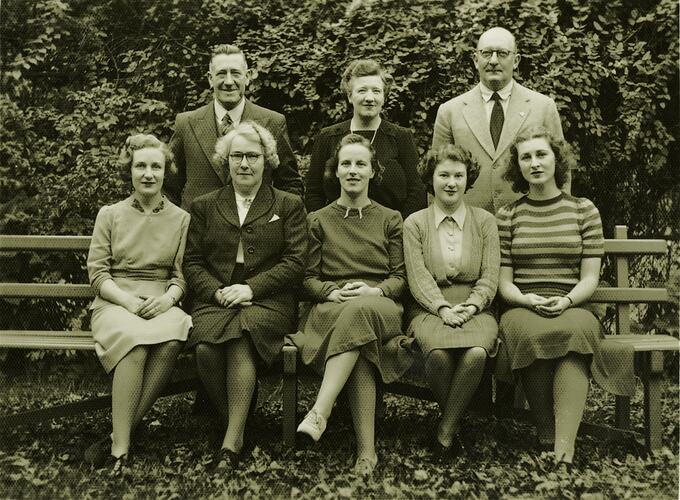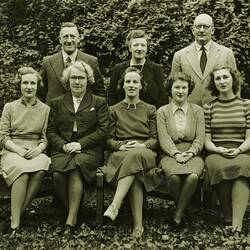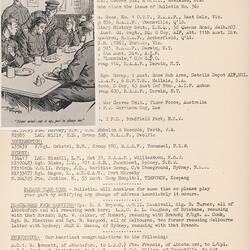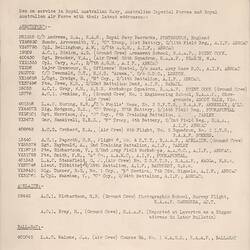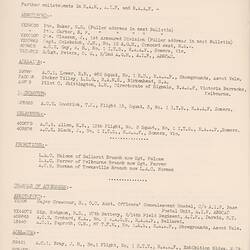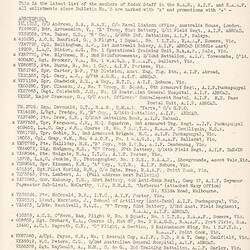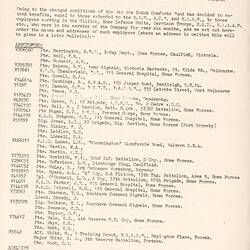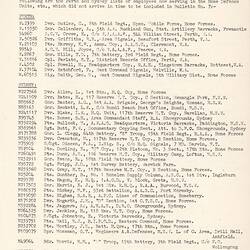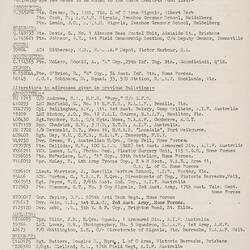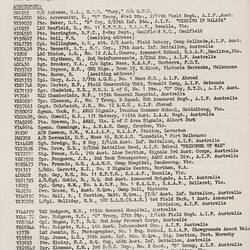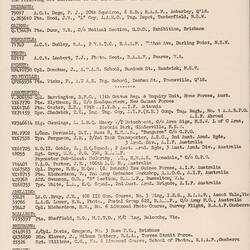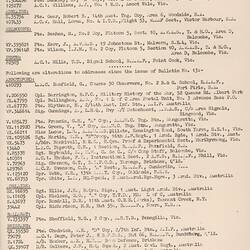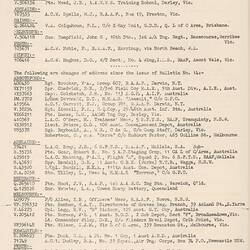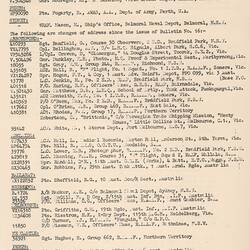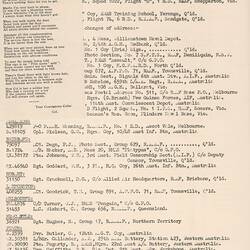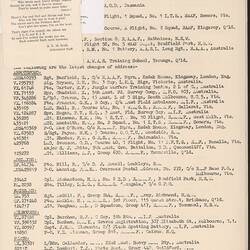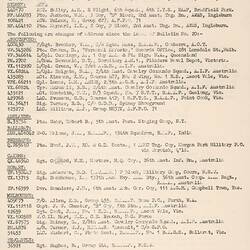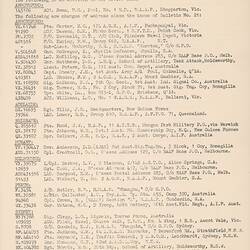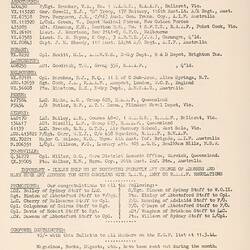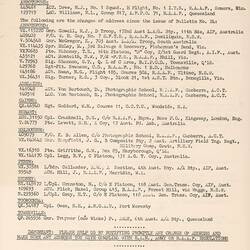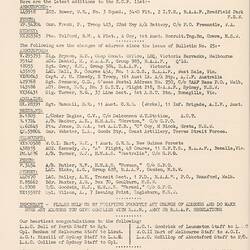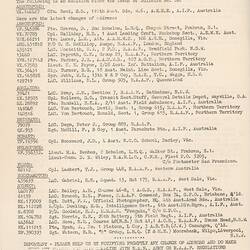The Kodak Staff Service Bulletin was a newsletter distributed by the Kodak Comforts Fund during World War II which provided a means for Kodak Australasia staff at home and overseas to communicate with and support one another. There were 40 issues of the Bulletin distributed to both serving and non-serving Kodak employees, and their families, across the 5 years of the newsletter's publication, 1941-1946. Service personnel's issues included extras such as cash donations, cartoons, and photocopied general interest articles.
The Bulletins are unassuming objects with a powerful impact. They appear as simple, typed, black and white sheets of paper, stapled in the corner. However, each issue starts with the names of Kodak men and women newly serving in the War, followed by those who have been promoted, discharged, wounded or killed. The names are sorted by Kodak branch. Following this, they report the 'Comforts' distributed. For instance, on September 13th 1941 the Kodak Comforts Fund (or K.C.F) reported that it had given 10 shillings to all active Service personnel and issued 18 pairs of knitted stockings, 9 pairs of socks, 2 pairs of gloves, 4 scarves, 8 pullovers, 2 balaclavas, 2 caps, and 2 pairs of mittens.
An irregular segment, 'General', includes miscellaneous updates from Australia such as rationing introductions and Kodak factory production information. There are also updates on fundraising activities like dances and exhibitions. In one colourful example from 1944, Mr Gordon Clark of Abbotsford's Cine Processing Department exhibited his 'collection of fish' for a silver coin donation, raising 23 pounds, 17 shillings.
The main body of the Bulletins forms the most powerful and personal historical resource. 'Extracts From Letters Received' included several pages of edited, unattributed letters written by employees serving in the War.
"Had a look over the Belsen Camp the other day - the huts are all burnt down of course (and that's a good thing) but the gallows and incinerators are still there. Graves about the size of tennis courts hold from 3000 to 5000 bodies - the place gives you cause to wonder what would have been our lot if things had turned out differently". Issue 38, Page 4, 17 Nov 1945.
The letters provide detailed and very personal insights into life during wartime. Many were written from trenches and army camps, and describe in detail the conditions of the author's placement - the dirt, the insects, the lack of provisions, the heat, the cold, the food.
"I have to apologise for the ink but during the last week it has been unobtainable so, having a pair of new overalls, I boiled them and this is a sample of the water after I had finished". Issue 26, Page 5, 03 June 1944.
Readers are transported across the globe to medical wards, to fly-invested Darwin mess halls and even to the bowels of a ship where one soldier was writing from a hammock slung between two sea mines. With complete candour the men and women of Kodak Australasia speak about their feelings towards the war and, in the final issues, towards peace time and thoughts of coming home.
"I guess there are a few happy people now that the Ninth Division is home. I should have had a brother with them but he was killed last October after going through nearly two years of it without a scratch. My other brother is a prisoner-of-war with the Japanese so I am just rarin' to get into a scrap and have a smack at them myself." Issue 17, page 4, 23 May 1943.
Flies, baths, fishing, making tea and dealing with the locals are common sources of anecdotes.
"We are running hot with parties in the Ward.I have finished trying to make a few Christmas decorations for our Mess, strangely enough the red paper and silver paper came from X-Ray Films made at good old Kodak". Issue 23, 29 January 1944.
There were regular Bulletin contributors and ongoing conversations about particular topics. In one example, the Fund issued a photograph of K.C.F staff (pictured). In the following Bulletin, there were several letters written in thanks that expressed not only the humour, but the loneliness felt by the soldiers - something that the Bulletins would have helped to alleviate:
"The group photo of those who help to publish the Kodak Bulletin proved very interesting - not only to me but to the rest of the chaps here also. With all due respect to Edgar Rouse and Jack Street it was the remainder of the group which claimed the centre of attraction. We don't see much "skirt" up here". Issue 33, 21 Apr 1945
Wherever a Kodak employee was posted, the Bulletin was a source of pride. Most Kodak employees shared the magazine with their fellow servicemen and women. It was an enviable resource in the camps because it represented job security - something that 6 years of war tended cast into doubt. One Kodak employee summed up this situation in their letter:
"Every serviceman and woman must, and does, wonder where all this will end - or rather where one will be at the end of hostilities.To some of my shipmates.it is a very real worry because jobs, businesses and professions they were engaged in have gone now and, what with their daily life of living on the edge of things, theirs is not a very enviable state of mind". Issue 18, page 4, 3 July 1943.
This collection of Kodak Staff Service Bulletins is important not only as a comprehensive reference to the service Kodak provided to its employees, but as a detailed insight into men's and women's experiences of World War II.
More Information
-
Keywords
-
Authors
-
Article types
